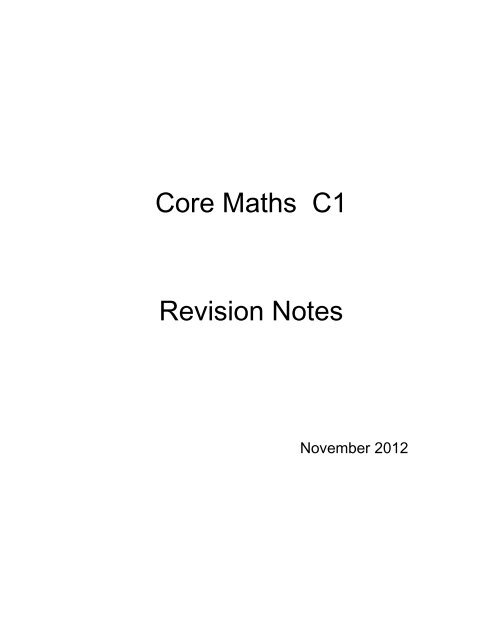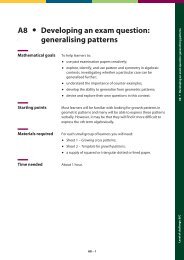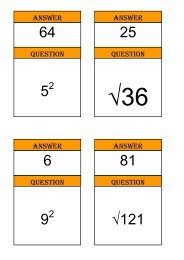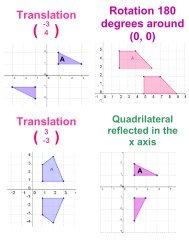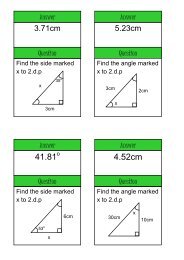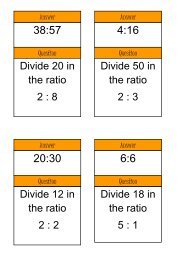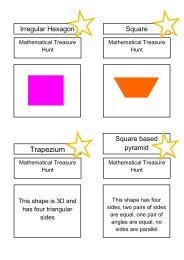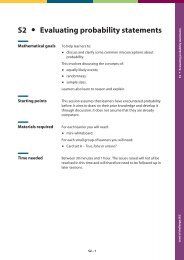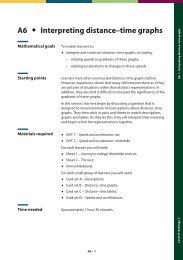Core Maths C1 Revision Notes - Mr Barton Maths
Core Maths C1 Revision Notes - Mr Barton Maths
Core Maths C1 Revision Notes - Mr Barton Maths
Create successful ePaper yourself
Turn your PDF publications into a flip-book with our unique Google optimized e-Paper software.
<strong>Core</strong> <strong>Maths</strong> <strong>C1</strong><br />
<strong>Revision</strong> <strong>Notes</strong><br />
November 2012
<strong>Core</strong> <strong>Maths</strong> <strong>C1</strong><br />
1 Algebra ................................................................................................................................ 3<br />
Indices ...................................................................................................................................... 3<br />
Rules of indices .................................................................................................................................................... 3<br />
Surds......................................................................................................................................... 4<br />
Simplifying surds ................................................................................................................................................. 4<br />
Rationalising the denominator............................................................................................................................. 4<br />
Quadratic functions.................................................................................................................. 4<br />
Completing the square. ........................................................................................................................................ 4<br />
Method 2 .............................................................................................................................................................. 5<br />
Factorising quadratics .......................................................................................................................................... 6<br />
Solving quadratic equations. .................................................................................................... 6<br />
by factorising. ...................................................................................................................................................... 6<br />
by completing the square ..................................................................................................................................... 6<br />
by using the formula ............................................................................................................................................ 6<br />
The discriminant b 2 – 4ac .................................................................................................................................. 7<br />
Miscellaneous quadratic equations...................................................................................................................... 7<br />
Quadratic graphs ..................................................................................................................... 8<br />
Simultaneous equations............................................................................................................ 9<br />
Two linear equations ........................................................................................................................................... 9<br />
One linear and one quadratic. .............................................................................................................................. 9<br />
Inequalities ............................................................................................................................. 10<br />
Linear inequalities ............................................................................................................................................. 10<br />
Quadratic inequalities ........................................................................................................................................ 10<br />
3 Coordinate geometry ....................................................................................................... 11<br />
Distance between two points .................................................................................................. 11<br />
Gradient ................................................................................................................................. 11<br />
Equation of a line ................................................................................................................... 11<br />
Parallel and perpendicular lines ........................................................................................... 11<br />
4 Sequences and series ........................................................................................................ 12<br />
Definition by a formula x n = f(n) ........................................................................................... 12<br />
Definitions of the form x n+1 = f(x n ) ........................................................................................ 12<br />
Series and Σ notation ............................................................................................................. 12<br />
Arithmetic series .................................................................................................................... 12<br />
Proof of the formula for the sum of an arithmetic series .................................................................................. 13<br />
5 Curve sketching ................................................................................................................ 14<br />
Standard graphs ..................................................................................................................... 14<br />
Transformations of graphs ..................................................................................................... 15<br />
Translations ........................................................................................................................................................ 15<br />
Stretches ............................................................................................................................................................. 15<br />
Reflections in the x-axis .................................................................................................................................... 18<br />
Reflections in the y–axis .................................................................................................................................... 18<br />
<strong>C1</strong> 14/04/2013 SDB<br />
1
6 Differentiation .................................................................................................................. 20<br />
General result ........................................................................................................................ 20<br />
Tangents and Normals ........................................................................................................... 20<br />
Tangents ............................................................................................................................................................ 20<br />
Normals ............................................................................................................................................................. 21<br />
7 Integration ........................................................................................................................ 22<br />
Indefinite integrals ................................................................................................................. 22<br />
Finding the arbitrary constant ........................................................................................................................... 22<br />
Index .......................................................................................................................................... 23<br />
2<br />
<strong>C1</strong> 14/04/2013 SDB
1 Algebra<br />
Indices<br />
Rules of indices<br />
a m × a n = a m+n<br />
a m ÷ a n = a m–n a 0 = 1<br />
(a m ) n = a mn<br />
a –n =<br />
1<br />
n<br />
a<br />
a<br />
1<br />
n<br />
m n<br />
=<br />
n<br />
a<br />
n<br />
( )<br />
n m<br />
a = a = a<br />
m<br />
Examples:<br />
(i) 5 –3 × 5 4 = 5 –3 + 4 = 5 1 = 5.<br />
7 –4 × 7 –2 = 7 –4 + –2 = 7 –4 – 2 = 7 –6 =<br />
(ii) 3 5 ÷ 3 –2 = 3 5 – –2 = 3 5 + 2 = 3 7 .<br />
9 –4 ÷ 9 6 = 9 –4 – 6 = 9 –10 1<br />
=<br />
9 10<br />
1<br />
7 6 .<br />
11 –3 ÷ 11 –5 = 11 –3 – –5 = 11 –3 + 5 = 11 2 = 121<br />
(iii) (6 –3 ) 4 = 6 –3 × 4 = 6 –12 1<br />
=<br />
6 . 12<br />
(iv)<br />
2 1<br />
2<br />
64 3<br />
64 3 2<br />
= ⎛ ⎝ ⎜ ⎞⎟ ⎠<br />
= ( 4)<br />
= 16<br />
− 2 1<br />
(v) 125 3<br />
= since minus means turn upside down<br />
2<br />
125 3<br />
1<br />
3<br />
= , since 3 on bottom of fraction is cube root, 125 = 5<br />
2<br />
5<br />
1<br />
=<br />
25<br />
Example: (16 a ) ÷ (8 b ) = (2 4 ) a ÷ (2 3 ) b = 2 4a ÷ 2 3b = 2 4a – 3b .<br />
Example: Find x if 9 2x = 27 x + 1 .<br />
Solution: First notice that 9 = 3 2 and 27 = 3 3 and so<br />
9 2x = 27 x + 1 ⇒ (3 2 ) 2x = (3 3 ) x + 1<br />
⇒ 3 4x = 3 3x + 3<br />
⇒ 4x = 3x + 3 ⇒ x = 3.<br />
<strong>C1</strong> 14/04/2013 SDB<br />
3
Surds<br />
A surd is a ‘nasty’ root – i.e. a root which is not rational<br />
Thus 64 8 3 1 1 5<br />
= , 27<br />
= 3<br />
, − 243 = −3<br />
are rational and not surds<br />
5 3<br />
and 5, 45, − 72 are irrational and are surds.<br />
Simplifying surds<br />
Example: To simplify 50 we notice that 50 = 25 × 2 = 5 2 × 2<br />
⇒ 50 = 25 × 2 = 25 × 2 = 5 2 .<br />
3<br />
Example: To simplify 40 we notice that 40 = 8 × 5 = 2 3 × 5<br />
3 3 3 3 3<br />
⇒ 40 = 8 × 5 = 8 × 5 = 2 × 5 .<br />
Rationalising the denominator<br />
Rationalising means getting rid of surds.<br />
We remember that multiplying (a + b) by (a – b) gives a 2 – b 2<br />
squaring both a and b at the same time!!<br />
which has the effect of<br />
Example:<br />
Rationalise the denominator of<br />
2+<br />
3 5<br />
.<br />
3−<br />
5<br />
Solution:<br />
2+<br />
3 5<br />
3−<br />
5<br />
=<br />
2+<br />
3 5<br />
3−<br />
5<br />
×<br />
3+<br />
5<br />
3+<br />
5<br />
=<br />
6+ 3 5 5+ 9 5+<br />
2 5<br />
2<br />
3 − 5<br />
2<br />
=<br />
21+<br />
11 5<br />
4<br />
.<br />
Quadratic functions<br />
A quadratic function is a function ax 2 + bx + c, where a, b and c are constants and the highest<br />
power of x is 2.<br />
Completing the square.<br />
Method 1<br />
Rule: 1] The coefficient of x 2 must be 1.<br />
2] Halve the coefficient of x, square it then add it and subtract it.<br />
Example: Complete the square in x 2 – 6x + 7.<br />
Solution: 1] The coefficient of x 2 is already 1,<br />
4<br />
<strong>C1</strong> 14/04/2013 SDB
2] the coefficient of x is –6, halve it to give –3 then square to give 9 and<br />
add and subtract<br />
x 2 – 6x + 7 = x 2 – 6x + 9 – 9 + 7<br />
= (x – 3) 2 – 2.<br />
Notice that the minimum value of the expression is –2 when x = 3, since the<br />
minimum value of (x – 3) 2 is 0.<br />
Example: Complete the square in 3x 2 + 24x – 5.<br />
Solution: 1] The coefficient of x 2 is not 1, so we must ‘fiddle’ it to make it 1, and<br />
then go on to step 2].<br />
3x 2 + 24x – 5 = 3(x 2 + 8x) – 5<br />
= 3(x 2 + 8x + 4 2 – 4 2 ) – 5<br />
= 3(x + 4) 2 – 48 – 5<br />
= 3(x + 4) 2 – 53<br />
Notice that the minimum value of the expression is –53 when x = –4, since<br />
the minimum value of (x + 4) 2 is 0. Thus the vertex of the curve is at (–4, –53).<br />
Method 2<br />
Example:<br />
Re-write x 2 – 12x + 7 in completed square form<br />
Solution: We know that we need -6 (half the coefficient of x)<br />
and that (x – 6) 2 = x 2 – 12x + 36<br />
⇒ x 2 – 12x + 7 = (x – 6) 2 – 27<br />
Notice that the minimum value of the expression is –27 when x = 6, since the<br />
minimum value of (x – 6) 2 is 0. Thus the vertex of the curve is at (6, –27).<br />
Example: Express 3x 2 + 12x – 2 in completed square form.<br />
Solution: The coefficient of x 2 is not 1 so we must ‘take 3 out’<br />
3x 2 + 12x – 2 = 3(x 2 + 4x) – 2<br />
and we know that (x + 2) 2 = x 2 + 4x + 4, so x 2 + 4x = (x + 2) 2 – 4<br />
⇒ 3x 2 + 12x – 2 = 3(x 2 + 4x) – 2 = 3[(x + 2) 2 – 4] – 2<br />
= 3(x + 2) 2 – 14<br />
Notice that the minimum value of the expression is –14 when x = –2, since<br />
the minimum value of (x – 2) 2 is 0. Thus the vertex of the curve is at (–2, –14).<br />
<strong>C1</strong> 14/04/2013 SDB<br />
5
Factorising quadratics<br />
All the coefficients must be whole numbers (integers) then the factors will also have whole<br />
number coefficients.<br />
Example: Factorise 10x 2 + 11x – 6.<br />
Solution: Looking at the 10x 2 and the –6 we see that possible factors are<br />
(10x ± 1), (10x ± 2), (10x ± 3), (10x ± 6),<br />
(5x ± 1), (5x ± 2), (5x ± 3), (5x ± 6),<br />
(2x ± 1), (2x ± 2), (2x ± 3), (2x ± 6),<br />
(x ± 1), (x ± 2), (x ± 3), (x ± 6),<br />
Also the –6 tells us that the factors must have opposite signs, and by trial and error or<br />
common sense<br />
10x 2 + 11x – 6 = (2x + 3)(5x – 2).<br />
Solving quadratic equations.<br />
by factorising.<br />
Example: x 2 – 5x + 6 = 0 ⇒ (x – 3)(x – 2) = 0<br />
⇒ x – 3 = 0 or x – 2 = 0 ⇒ x = 3 or x = 2.<br />
Example: x 2 + 8x = 0 ⇒ x(x + 8) = 0<br />
⇒ x = 0 or x + 8 = 0 ⇒ x = 0 or x = –8<br />
N.B. Do not divide through by x first: you will lose the root of x = 0.<br />
by completing the square<br />
Example: x 2 – 6x – 3 = 0<br />
⇒ x 2 – 6x = 3<br />
and (x – 3) 2 = x 2 – 6x + 9<br />
⇒ x 2 – 6x + 9 = 3 + 9 ⇒ (x – 3) 2 = 12<br />
⇒ (x – 3) = ±√12 ⇒ x = 3 ± √12 = – 0.464 or 6.46.<br />
by using the formula<br />
always try to factorise first.<br />
Example:<br />
ax 2 + bx + c = 0 ⇒ x =<br />
− b ±<br />
2<br />
b − 4ac<br />
2a<br />
3x 2 – x – 5 = 0 will not factorise, so we use the formula with<br />
a = 3, b = –1, c = –5<br />
⇒ x =<br />
2<br />
−− 1 ± ( − 1) − 4 × 3 × ( − 5)<br />
2 × 3<br />
= –1.135 or +1.468<br />
6<br />
<strong>C1</strong> 14/04/2013 SDB
The discriminant b 2 – 4ac<br />
In the formula for the quadratic equation<br />
ax 2 + bx + c = 0 ⇒ x =<br />
− b ±<br />
2<br />
b − 4ac<br />
2a<br />
i) there will be two distinct real roots if b 2 – 4ac > 0<br />
ii) there will be only one real root if b 2 – 4ac = 0<br />
iii) there will be no real roots if b 2 – 4ac < 0<br />
Example: For what values of k does the equation 3x 2 – kx + 5 = 0 have<br />
i) two distinct real roots,<br />
ii) exactly one real root<br />
iii) no real roots.<br />
Solution: The discriminant b 2 – 4ac = (–k) 2 – 4 × 3 × 5 = k 2 – 60<br />
⇒ i) for two distinct real roots k 2 – 60 > 0<br />
⇒ k 2 > 60 ⇒ k < –√60, or k > +√60<br />
and ii) for only one real root k 2 – 60 = 0<br />
⇒ k = ±√60<br />
and iii) for no real roots k 2 – 60 < 0<br />
⇒ –√60 < k < +√60.<br />
Miscellaneous quadratic equations<br />
a) 2 sin 2 x – sin x – 1 = 0.<br />
Put y = sin x to give 2y 2 – y – 1 = 0<br />
⇒ (y – 1)(2y + 1) = 0 ⇒ y = 1 or y = –½<br />
⇒ sin x = 1 or –½ ⇒ x = 90°, 210° or 330° from 0° to 360°.<br />
b) 3 2x – 10 × 3 x + 9 = 0<br />
Notice that 3 2x = (3 x ) 2 and put y = 3 x to give<br />
y 2 – 10y + 9 = 0 ⇒ (y – 9)(y – 1) = 0<br />
⇒ y = 9 or y = 1<br />
⇒ 3 x = 9 or 3 x = 1 ⇒ x = 2 or x = 0.<br />
c) y – 3√y + 2 = 0. Put √y = x to give<br />
x 2 – 3x + 2 = 0 and solve to give x = 2 or 1<br />
⇒ y = x 2 = 4 or 1.<br />
<strong>C1</strong> 14/04/2013 SDB<br />
7
Quadratic graphs<br />
a) If a > 0 the parabola will be ‘the right way up’<br />
i) if b 2 – 4ac > 0 the curve will meet<br />
the x-axis in two points.<br />
ii)<br />
if b 2 – 4ac = 0 the curve will meet the<br />
x-axis in only one point (it will touch<br />
the axis)<br />
iii)<br />
if b 2 – 4ac < 0 the curve will not meet<br />
the x-axis.<br />
b) a) If a < 0 the parabola will be ‘the wrong way up’<br />
i) if b 2 – 4ac > 0 the curve will meet<br />
the x-axis in two points.<br />
ii)<br />
if b 2 – 4ac = 0 the curve will meet the<br />
x-axis in only one point (it will touch<br />
the axis)<br />
iii)<br />
if b 2 – 4ac < 0 the curve will not meet<br />
the x-axis.<br />
Note: When sketching the curve of a quadratic function you should always show the value on<br />
the y-axis and<br />
if you have factorised you should show the values where it meets the x-axis,<br />
if you have completed the square you should give the co-ordinates of the vertex.<br />
8<br />
<strong>C1</strong> 14/04/2013 SDB
Simultaneous equations<br />
Two linear equations<br />
Example: Solve 3x – 2y = 4 and 4x + 7y = 15.<br />
Solution: Make the coefficients of x (or y) equal then add or subtract the equations to<br />
eliminate x (or y).<br />
Here 4 times the first equation gives 12x – 8y = 16<br />
and 3 times the second equation gives 12x + 21y = 45<br />
Subtracting gives –29y = –29 ⇒ y = 1<br />
Put y = 1 in equation one ⇒ 3x = 4 + 2y = 4 + 2 ⇒ x = 2<br />
Check in equation two: L.H.S. = 4 × 2 + 7 × 1 = 15 = R.H.S.<br />
One linear and one quadratic.<br />
Find x (or y) from the Linear equation and substitute in the Quadratic equation.<br />
Example: Solve x – 2y = 3, x 2 – 2y 2 – 3y = 5<br />
Solution: From first equation x = 2y + 3<br />
Substitute in second ⇒ (2y + 3) 2 – 2y 2 – 3y = 5<br />
⇒ 4y 2 + 12y + 9 – 2y 2 – 3y = 5<br />
⇒ 2y 2 + 9y + 4 = 0 ⇒ (2y + 1)(y + 4) = 0<br />
⇒ y = –½ or y = –4<br />
⇒ x = 2 or x = –5 from the linear equation.<br />
Check in quadratic for x = 2, y = –½<br />
L.H.S. = 2 2 – 2(–½) 2 – 3(–½) = 5 = R.H.S.<br />
and for x = –5, y = –4<br />
L.H.S. = (–5) 2 – 2(–4) 2 – 3(–4) = 25 – 32 + 12 = 5 = R.H.S.<br />
<strong>C1</strong> 14/04/2013 SDB<br />
9
Inequalities<br />
Linear inequalities<br />
Solving algebraic inequalities is just like solving equations, add, subtract, multiply or<br />
divide the same number to, from, etc. BOTH SIDES<br />
EXCEPT - if you multiply or divide both sides by a NEGATIVE number then you<br />
must TURN THE INEQUALITY SIGN ROUND.<br />
Example: Solve 3 + 2x < 8 + 4x<br />
Solution:<br />
sub 3 from B.S. ⇒ 2x < 5 + 4x<br />
sub 4x from B.S. ⇒ -2x < 5<br />
divide B.S. by -2 and turn the inequality sign round<br />
⇒ x > - 2.5.<br />
Example: Solve x 2 > 16<br />
Solution: We must be careful here since the square of a negative number is positive<br />
giving the full range of solutions as<br />
⇒ x < -4 or x > +4.<br />
Quadratic inequalities<br />
Always sketch a graph and find where the curve meets the x-axis<br />
Example: Find the values of x which satisfy<br />
3x 2 – 5x – 2 ≥ 0.<br />
Solution:<br />
3x 2 – 5x – 2 = 0<br />
y<br />
⇒ (3x + 1)(x – 2) = 0<br />
⇒ x = – 1 / 3 or 2<br />
We want the part of the curve which is above<br />
or on the x-axis<br />
⇒ x ≤ – 1 / 3 or x ≥ 2<br />
-5<br />
x<br />
10<br />
<strong>C1</strong> 14/04/2013 SDB
3 Coordinate geometry<br />
Distance between two points<br />
2<br />
Distance between P (a 1 , b 1 ) and Q (a 2 , b 2 ) is ( a − a ) + ( b − b )<br />
Gradient<br />
Gradient of PQ is m b −<br />
=<br />
b<br />
a − a<br />
2 1<br />
2 1<br />
1 2<br />
1 2<br />
Equation of a line<br />
Equation of the line PQ, above, is y = mx + c and use a point to find c<br />
or the equation of the line with gradient m through the point (x 1 , y 1 ) is<br />
y – y 1 = m(x – x 1 )<br />
or the equation of the line through the points (x 1 , y 1 ) and (x 2 , y 2 ) is<br />
y − y<br />
x − x<br />
1<br />
1<br />
=<br />
y<br />
x<br />
2<br />
2<br />
− y<br />
− x<br />
1<br />
1<br />
(you do not need to know this one!!)<br />
2<br />
Parallel and perpendicular lines<br />
Two lines are parallel if they have the same gradient<br />
and they are perpendicular if the product of their gradients is –1.<br />
Example: Find the equation of the line through (4½, 1) and perpendicular to the line<br />
joining the points A (3, 7) and B (6, -5).<br />
Solution:<br />
7 − −5<br />
Gradient of AB is = −4<br />
3 − 6<br />
⇒ gradient of line perpendicular to AB is ¼ , (product of perpendicular gradients is –1)<br />
so we want the line through (4½, 1) with gradient ¼ .<br />
Using y – y 1 = m(x – x 1 ) ⇒ y – 1 = ¼ (x – 4½)<br />
⇒ 4y – x = - ½ or – 2x + 8y + 1 = 0.<br />
<strong>C1</strong> 14/04/2013 SDB<br />
11
4 Sequences and series<br />
A sequence is any list of numbers.<br />
Definition by a formula x n = f(n)<br />
Example: The definition x n = 3n 2 – 5 gives<br />
x 1 = 3 × 1 2 – 5 = –2, x 2 = 3 × 2 2 – 5 = 7, x 3 = 3 × 3 2 – 5 = 22, … .<br />
Definitions of the form x n+1 = f(x n )<br />
These have two parts:– (i) a starting value (or values)<br />
(ii) a method of obtaining each term from the one(s) before.<br />
Examples: (i) The definition x 1 = 3 and x n = 3x n –1 + 2<br />
defines the sequence 3, 11, 35, 107, . . .<br />
(ii) The definition x 1 = 1, x 2 = 1, x n = x n –1 + x n –2<br />
defines the sequence 1, 1, 2, 3, 5, 8, 13, 21, 34, 65, . . . .<br />
This is the Fibonacci sequence.<br />
Series and Σ notation<br />
A series is the sum of the first so many terms of a sequence.<br />
For a sequence whose nth term is x n = 2n +3 the sum of the first n terms is a series<br />
S n = x 1 + x 2 + x 3 + x 4 . . . + x n = 5 + 7 + 9 + 11 + . . . + (2n + 3)<br />
n<br />
x i<br />
i=<br />
1<br />
This is written in Σ notation as S n = ∑<br />
n<br />
= ∑ ( 2i<br />
+ 3)<br />
and is a finite series of n terms.<br />
i=<br />
1<br />
An infinite series has an infinite number of terms S ∞ = ∑ ∞<br />
i=1<br />
Arithmetic series<br />
An arithmetic series is a series in which each term is a constant amount bigger (or smaller)<br />
than the previous term: this constant amount is called the common difference.<br />
Examples: 3, 7, 11, 15, 19, 23, . . . . with common difference 4<br />
28, 25, 22, 19, 16, 13, . . . with common difference –3.<br />
x<br />
i<br />
.<br />
Generally an arithmetic series can be written as<br />
S n = a + (a + d) + (a + 2d) + (a + 3d) + (a + 4d) + . . . upto n terms,<br />
where the first term is a and the common difference is d.<br />
The nth term x n = a + (n – 1)d<br />
The sum of the first n terms of the above arithmetic series is<br />
12<br />
<strong>C1</strong> 14/04/2013 SDB
n<br />
2 2 1<br />
S n = ( a + ( n − ) d)<br />
, or S n = ( L )<br />
n a + where L is the last term.<br />
2<br />
Example: Find the nth term and the sum of the first 100 terms of the arithmetic series with<br />
3 rd term 5 and 7 th term 17.<br />
Solution: x 7 = x 3 + 4 × d<br />
⇒ 17 = 5 + 4 × d ⇒ d = 3<br />
⇒ x 1 = x 3 – 2 × d ⇒ x 1 = 5 – 6 = –1<br />
⇒ nth term x n = a + (n – 1)d = –1 + 3(n – 1)<br />
and ⇒ S 100 = 100 / 2 × (2 × –1 + (100 – 1) × 3) = 14750.<br />
Proof of the formula for the sum of an arithmetic series<br />
You must know this proof.<br />
First write down the general series and then write it down in reverse order<br />
S n = a + (a + d) + (a + 2d) + ….. + (a + (n – 2)d) + (a + (n – 1)d<br />
⇒ S n = (a + (n – 1)d + (a + (n – 2)d) + (a + (n – 3)d) + … + (a + d) + a ADD<br />
⇒ 2 × S n = (2a + (n – 1)d) + (2a + (n – 1)d) + (2a + (n – 1)d) + … (2a + (n – 1)d) + (2a + (n – 1)d)<br />
⇒ 2 × S n = n(2a + (n – 1)d)<br />
⇒ S n = n / 2 × (2a + (n – 1)d),<br />
Which can be written as<br />
S n = n / 2 × (a + a + (n – 1)d) = n / 2 × (a + L), where L is the last term.<br />
<strong>C1</strong> 14/04/2013 SDB<br />
13
5 Curve sketching<br />
Standard graphs<br />
3y<br />
2<br />
1<br />
x<br />
-4 -3 -2 -1 1 2 3 4 5<br />
-1<br />
-2<br />
3y<br />
2<br />
1<br />
x<br />
-4 -3 -2 -1 1 2 3 4 5<br />
-1<br />
-2<br />
3y<br />
2<br />
1<br />
x<br />
-4 -3 -2 -1 1 2 3 4 5<br />
-1<br />
-2<br />
-3<br />
-3<br />
-3<br />
y = x y = -x<br />
y = x 2<br />
3y<br />
2<br />
1<br />
x<br />
-4 -3 -2 -1 1 2 3 4 5<br />
-1<br />
-2<br />
-3<br />
3y<br />
2<br />
1<br />
x<br />
-4 -3 -2 -1 1 2 3 4 5<br />
-1<br />
-2<br />
-3<br />
3y<br />
2<br />
1<br />
x<br />
-4 -3 -2 -1 1 2 3 4 5<br />
-1<br />
-2<br />
-3<br />
y = x 3 y = 1/x y = 1/x 2<br />
3y<br />
y<br />
20<br />
2<br />
1<br />
x<br />
-4 -3 -2 -1 1 2 3 4 5<br />
-1<br />
10<br />
-2<br />
-3<br />
y = √x<br />
x<br />
-4 -3 -2 -1 1 2 3 4 5 6 7 8 9 1<br />
The exponential curve y =2 x<br />
y =3x 2 is like y = x 2 but steeper: similarly for y = 5x 3 and y = 7 / x , etc.<br />
a<br />
b<br />
c<br />
>x a b<br />
>x<br />
y = (x – a)(x – b)(x – c) y = (x – a) 2 (x – b)<br />
a b c<br />
>x<br />
a<br />
b<br />
>x<br />
y = (a – x)(x – b)(x – c) y = (a – x)(x – b) 2<br />
14<br />
<strong>C1</strong> 14/04/2013 SDB
Transformations of graphs<br />
Translations<br />
(i) If the graph of y = x 2 + 3x is translated through +5 in the y-direction the equation of<br />
the new graph is y = x 2 + 3x + 5;<br />
and in general if we know that y is given by some formula involving x, which we write<br />
as y = f (x), then the new curve after a translation through +5 units in the y direction is<br />
y = f (x) + 5.<br />
(ii) If the graph of y = x 2 + 3x is translated through +5 in the x-direction the equation of<br />
the new graph is y = (x - 5) 2 + 3(x - 5);<br />
and if y = f (x), then the new curve after a translation through +5 units in the x-direction<br />
is y = f (x - 5):<br />
i.e. we replace x by (x - 5) everywhere in the formula for y:<br />
note the minus sign, -5, which seems wrong but is correct!<br />
Example:<br />
4<br />
Y<br />
The graph of y = (x - 3) 2 + 2 is the graph of<br />
y = x 2<br />
⎛ + 3⎞<br />
after a translation of ⎜ ⎟<br />
⎝+<br />
2⎠<br />
y = x 2<br />
3<br />
2<br />
1<br />
y = (x - 3) 2 + 2<br />
0<br />
-2 -1 0 1 2 3 4 5 6<br />
X<br />
In general y = x 2 or y = f (x) becomes y = (x - a) 2 + b<br />
⎛ a<br />
or y = f (x - a) + b after a translation through ⎜ ⎞ ⎝ b⎠ ⎟<br />
Stretches<br />
(i)<br />
If the graph of y = x 2 + 3x is stretched by a factor of +5 in the y-direction.then the<br />
equation of the new graph is y = 5(x 2 + 3x);<br />
and in general if y is given by some formula involving x, which we write as y = f (x),<br />
then the new curve after a stretch by a factor of +5 in the y-direction is y = 5 × f (x).<br />
<strong>C1</strong> 14/04/2013 SDB<br />
15
Example:<br />
y = x 2 - 2<br />
4<br />
Y<br />
3<br />
The graph of y = x 2 - 2 becomes<br />
y = 3(x 2 - 2) after a stretch of factor 3 in<br />
the y-direction<br />
2<br />
1<br />
0<br />
-4 -3 -2 -1 0<br />
-1<br />
1 2 3 4<br />
-2<br />
X<br />
-3<br />
(ii)<br />
-6<br />
In general y = x 2 or y = f (x) becomes y = ax 2 or y = af (x)<br />
after a stretch in the y-direction of factor a.<br />
If the graph of y = x 2 + 3x is stretched by a factor of +3 in the x-direction then the<br />
2<br />
⎛ x ⎞ ⎛ x ⎞<br />
equation of the new graph is y = ⎜ ⎟ + 3 ⎜ ⎟<br />
⎝ 3 ⎠ ⎝ 3 ⎠<br />
and in general if y is given by some formula involving x, which we write as y = f (x),<br />
⎛ x<br />
then the new curve after a a stretch by a factor of +3 in the x-direction is y = f ⎜ ⎞ ⎝ 3⎠ ⎟<br />
x<br />
i.e. we replace x by<br />
3 everywhere in the formula for y.<br />
-4<br />
-5<br />
y = 3(x 2 - 2)<br />
16<br />
<strong>C1</strong> 14/04/2013 SDB
Example:<br />
In this example the graph of<br />
y = x 3 – 4 x<br />
has been stretched by a factor of 2 in<br />
the x-direction to form a new graph<br />
with equation<br />
3<br />
x x<br />
y = ⎛ ⎝ ⎜ ⎞<br />
⎟ − ⎛ ⎠ ⎝ ⎜ ⎞<br />
4 ⎟<br />
2 2 ⎠<br />
3<br />
x<br />
y = ⎛ ⎝ ⎜ ⎞<br />
⎟ − ⎛ ⎠ ⎝ ⎜ ⎞<br />
2<br />
y = x 3 – 4x<br />
8 Y<br />
7<br />
6<br />
5<br />
4<br />
3<br />
2<br />
1<br />
X<br />
0<br />
-5 -4 -3 -2 -1 -1 0 1 2 3 4 5<br />
-2<br />
-3<br />
-4<br />
-5<br />
-6<br />
x<br />
4 ⎟<br />
-7<br />
2 ⎠<br />
-8<br />
(iii)<br />
Note that to stretch by a factor of ¼ in the x-direction we replace x by<br />
that y = f (x) becomes y = f (4x)<br />
x<br />
= so<br />
1 4<br />
4x<br />
Example:<br />
In this example the graph of y = x 3 - 9 x<br />
has been stretched by a factor of 1 in the<br />
3<br />
x-direction to form a new graph with equation<br />
3<br />
( 3 ) 9( 3 )<br />
y = x − x = 27x 3 – 27x,<br />
The new equation is formed by replacing x<br />
x<br />
by = in the original equation.<br />
1 3<br />
3x<br />
15 Y<br />
13<br />
y = x 3 - 9 x<br />
11<br />
9<br />
7<br />
5<br />
3<br />
1<br />
X<br />
-5 -4 -3 -2<br />
-1<br />
-1 0<br />
-3<br />
1 2 3 4 5<br />
-5<br />
-7<br />
-9<br />
-11<br />
-13<br />
-15<br />
3<br />
( 3 ) 9( 3 )<br />
y = x − x<br />
<strong>C1</strong> 14/04/2013 SDB<br />
17
Reflections in the x-axis<br />
When reflecting in the x-axis all the positive y-coordinates become negative and vice<br />
versa and so the image of<br />
y = f (x) after reflection in the x-axis is y = – f (x).<br />
Example: The image of y = x 2 + 2x – 1 after<br />
reflection in the x-axis is<br />
y = –f (x)<br />
= –(x 2 + 2x – 1)<br />
= –x 2 – 2x + 1<br />
y = x 2 + 2x – 1.<br />
y<br />
2<br />
-4 -2 2 4<br />
-2<br />
y = – x 2 – 2x + 1.<br />
x<br />
Reflections in the y–axis<br />
When reflecting in the y-axis<br />
the y-coordinate for x = +3 becomes the y-coordinate for x = –3 and<br />
the y-coordinate for x = –2 becomes the y-coordinate for x = +2.<br />
Thus the equation of the new graph is found by replacing x by –x<br />
and the image of y = f (x) after reflection in the y–axis is y = f (–x).<br />
Example: The image of<br />
y = x 2 + 2x – 1<br />
after reflection in the y-axis is<br />
y = (–x) 2 + 2(–x) – 1<br />
= x 2 – 2x – 1<br />
y<br />
y = x 2 + 2x – 1 y = x 2 – 2x – 1<br />
2<br />
-4 -2 2 4<br />
-2<br />
x<br />
18<br />
<strong>C1</strong> 14/04/2013 SDB
Old equation Transformation New equation<br />
y = f (x)<br />
y = f (x)<br />
Translation through<br />
Stretch with factor a<br />
in the y-direction.<br />
⎛ a<br />
⎜ ⎞ ⎝ b⎠ ⎟<br />
y = f (x - a) + b<br />
y = a × f (x)<br />
y = f (x)<br />
y = f (x)<br />
Stretch with factor a<br />
in the x-direction.<br />
Stretch with factor<br />
in the x-direction.<br />
1<br />
a<br />
⎛ x ⎞<br />
y = f ⎜ ⎟<br />
⎝ a⎠<br />
y = f( ax )<br />
y = f (x) Reflection in the x-axis y = - f (x)<br />
y = f (x) Reflection in the y-axis y = f (-x)<br />
<strong>C1</strong> 14/04/2013 SDB<br />
19
6 Differentiation<br />
General result<br />
Differentiating is finding the gradient of the curve.<br />
y = x n<br />
⇒<br />
dy<br />
dx<br />
= nx<br />
n−1<br />
, or f (x) = x n ⇒ f ′(x) = nx n–1<br />
Examples:<br />
a) y = 3x 2 dy<br />
– 7x + 4<br />
= 6x – 7<br />
dx<br />
b)<br />
1<br />
1 7<br />
2<br />
2<br />
f (x) = 7√x = 7x f ( x)<br />
7 × 1 −<br />
′ = x =<br />
2<br />
2 x<br />
c)<br />
8 −3<br />
dy<br />
− −4 − 24<br />
y = = 8x<br />
= 8 × 3x<br />
=<br />
3 4<br />
x<br />
dx<br />
x<br />
d) f (x) = (2x + 1)(x – 3) multiply out first<br />
= 2x 2 – 5x – 3 f ′( x)<br />
= 4x<br />
− 5<br />
e)<br />
7 2<br />
3x<br />
− 4x<br />
y =<br />
5<br />
x<br />
split up first<br />
7 2<br />
3x<br />
4x<br />
2 −3<br />
dy<br />
−4 12<br />
= − = 3x<br />
− 4x<br />
= 6x<br />
− −12x<br />
= 6x<br />
+<br />
5 5<br />
4<br />
x x<br />
dx<br />
x<br />
Tangents and Normals<br />
Tangents<br />
Example:<br />
Find the equation of the tangent to y = 3x 2 – 7x + 5 at the point where x = 2.<br />
Solution:<br />
We first find the gradient when x = 2.<br />
y = 3x 2 – 7x + 5<br />
⇒<br />
dy<br />
dx<br />
= 6x – 7 and when x = 2,<br />
dy<br />
dx<br />
= 6 × 2 – 7 = 5.<br />
so the gradient when x = 2 is 5. The equation is of the form y = mx + c where m is<br />
the gradient so we have<br />
y = 5x + c.<br />
To find c we must find a point on the line, namely the point on the curve when x = 2.<br />
2<br />
When x = 2 the y – value on the curve is 3× 2 − 7 × 2 + 5 = 3 ,<br />
i.e. when x = 2, y = 3.<br />
Substituting these values in y = 5x + c we get 3 = 5 × 2 + c ⇒ c = –7<br />
⇒ the equation of the tangent is y = 5x – 7.<br />
20<br />
<strong>C1</strong> 14/04/2013 SDB
Normals<br />
(The normal to a curve is the line at 90 o to the tangent at that point).<br />
We first remember that if two lines with gradients m 1 and m 2 are perpendicular<br />
then m 1 × m 2 = –1.<br />
Example:<br />
Find the equation of the normal to the curve y = x+ 2 at the point where x = 2.<br />
x<br />
Solution:<br />
We first find the gradient of the tangent when x = 2.<br />
y = x + 2x –1 dy<br />
⇒<br />
dx = 1 – 2<br />
2x–2 = 1 –<br />
⇒ when x = 2 gradient of the tangent is m 1 = 1 – 2 4 = ½ .<br />
If gradient of the normal is m 2 then m 1 × m 2 = –1 ⇒ ½ × m 2 = –1 ⇒ m 2 = –2<br />
Thus the equation of the normal must be of the form y = –2x + c.<br />
From the equation y = x+ 2 the value of y when x = 2 is y = 2 + 2 = 3<br />
x<br />
2<br />
Substituting x = 2 and y = 3 in the equation of the normal y = –2x + c we have<br />
3 = –2 × 2 + c ⇒ c = 7<br />
⇒ equation of the normal is y = –2x + 7.<br />
2<br />
x<br />
<strong>C1</strong> 14/04/2013 SDB<br />
21
7 Integration<br />
Indefinite integrals<br />
n+<br />
1<br />
n x<br />
∫ x dx = + C<br />
provided that n ≠ –1<br />
n + 1<br />
N.B. NEVER FORGET THE ARBITRARY CONSTANT + C.<br />
Examples:<br />
4 4 −6<br />
= x dx<br />
3x<br />
3<br />
−5<br />
4 x − 4<br />
= × + C = + C<br />
5<br />
3 − 5 15x<br />
2<br />
(3x − 2)( x + 1) dx = 3x<br />
+ x 2 dx<br />
a) ∫ dx<br />
6 ∫<br />
b) ∫ ∫ −<br />
= x 3 + ½ x 2 – 2x + C.<br />
2<br />
+ 5x<br />
4 −<br />
dx = x + 5x<br />
dx<br />
5<br />
x<br />
5 2 5<br />
=<br />
x 5<br />
5<br />
x −<br />
+ × + C = x − + C<br />
2<br />
5 −2 5 2x<br />
9<br />
x 3<br />
c) ∫ ∫<br />
multiply out first<br />
split up first<br />
Finding the arbitrary constant<br />
If you know the derivative (gradient) function and a point on the curve you can find C.<br />
dy<br />
Example: Solve = 3x<br />
2 − 5 , given that y = 4 when x = 2.<br />
dx<br />
Solution: y = ∫ 3x 2 − 5 dx = x 3 – 5x + C but y = 4 when x = 2<br />
⇒ 4 = 2 3 – 5 × 2 + C ⇒ C = 6<br />
⇒ y = x 3 – 5x + 6.<br />
22<br />
<strong>C1</strong> 14/04/2013 SDB
Index<br />
Differentiation, 20<br />
Distance between two points, 11<br />
Equation of a line, 11<br />
Gradient, 11<br />
Graphs<br />
Reflections, 18<br />
Standard graphs, 14<br />
Stretches, 15<br />
Translations, 15<br />
Indices, 3<br />
Inequalities<br />
linear inequalities, 10<br />
quadratic inequalities, 10<br />
Integrals<br />
finding arbitrary constant, 22<br />
indefinite, 22<br />
Normals, 21<br />
Parallel and perpendicular lines, 11<br />
Quadratic equations<br />
b 2 – 4ac, 7<br />
completing the square, 6<br />
factorising, 6<br />
formula, 6<br />
miscellaneous, 7<br />
Quadratic functions, 4<br />
completing the square, 4<br />
factorising, 6<br />
vertex of curve, 5<br />
Quadratic graphs, 8<br />
Series<br />
Arithmetic, 12<br />
Arithmetic, proof of sum, 13<br />
Sigma notation, 12<br />
Simultaneous equations<br />
one linear equations and one quadratic, 9<br />
two linear equations, 9<br />
Surds, 4<br />
rationalising the denominator, 4<br />
Tangents, 20<br />
<strong>C1</strong> 14/04/2013 SDB<br />
23


